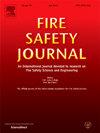包层应用BS 8414测试的CFD模拟
IF 3.4
3区 工程技术
Q2 ENGINEERING, CIVIL
引用次数: 0
摘要
利用表面着火温度、锥量热计数据和木槽的放热率曲线,建立了模拟覆层火灾的数值BS 8414模型。该模型预测了可燃材料的燃烧速率、温度分布、材料的烧透、燃烧位置和功能性膨胀腔屏障的激活状态。通过正确再现合格/不合格结果和失效机制,使用7次DCLG BS 8414测试验证了该模型;产生可比较的火焰和合理一致的温度分布,这对通过/不合格标准至关重要;并为覆层系统制定合理的燃烧/燃烧位置。该模型还被用于研究影响火灾蔓延的因素,包括空腔大小、防火屏障的状态、核心材料质量的减少(例如滴水)以及木槽火源的HRR行为的一致性。讨论了BS 8414模型的局限性,包括表面着火温度的不确定性;膨胀腔屏障的激活途径木槽火的hrr和材料性能的不确定性。为了提高BS 8414测试的可重复性,建议使用燃气燃烧器而不是木槽火。本文章由计算机程序翻译,如有差异,请以英文原文为准。
CFD simulation of the BS 8414 test for cladding applications
A numerical BS 8414 model has been developed using surface ignition temperature, cone calorimeter data and a heat release rate curve from a wood crib, for simulating cladding fires. The model predicts burning rates of combustible materials, temperature profiles, burn-through of materials, burning locations and activation states of functional intumescent cavity barriers. The model is validated using seven DCLG BS 8414 tests, by correctly reproducing pass/fail results and failure mechanisms; producing comparable fire flames and reasonable agreement of temperature profiles, which are essential to the pass/fail criteria; and producing reasonable burning/burnt locations for the cladding system. The model has also been used to investigate factors affecting fire spread including cavity size, state of fire barriers, reduction of core material mass by for example dripping and the consistency of the HRR behaviour of the wood crib fire source. The limitations of the BS 8414 model are discussed including the uncertainty of surface ignition temperature; the approach to the activation of intumescent cavity barriers; the uncertainties in HRRs of the wood crib fire and the material properties. To improve the repeatability of the BS 8414 test, it is suggested that a gas burner is used rather than a wood crib fire.
求助全文
通过发布文献求助,成功后即可免费获取论文全文。
去求助
来源期刊

Fire Safety Journal
工程技术-材料科学:综合
CiteScore
5.70
自引率
9.70%
发文量
153
审稿时长
60 days
期刊介绍:
Fire Safety Journal is the leading publication dealing with all aspects of fire safety engineering. Its scope is purposefully wide, as it is deemed important to encourage papers from all sources within this multidisciplinary subject, thus providing a forum for its further development as a distinct engineering discipline. This is an essential step towards gaining a status equal to that enjoyed by the other engineering disciplines.
 求助内容:
求助内容: 应助结果提醒方式:
应助结果提醒方式:


